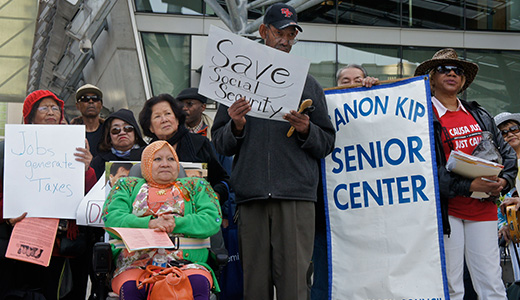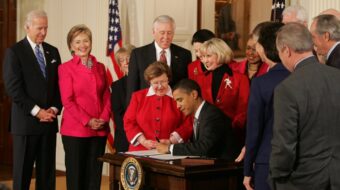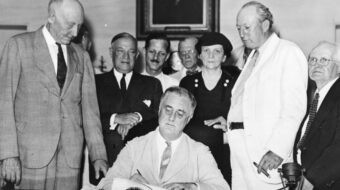
The developing struggle to protect Social Security from the Republicans and the federal Fiscal Reform Commission won a victory recently in President Obama’s State of the Union address. There’s an important lesson for us here.
In his speech, Obama said:
“To put us on solid ground, we should also find a bipartisan solution to strengthen Social Security for future generations. And we must do it without putting at risk current retirees, the most vulnerable, or people with disabilities, without slashing benefits for future retirees, and without subjecting American’s guaranteed income to the whims of the stock market.”
This is a solid statement that won praise from activists fighting to defend Social Security. Obama took a position in opposition to the findings of the Fiscal Reform Commission that he appointed. His statement, further, is in opposition to the divisive push by corporate forces to split young folks from retirees, central to their drive to destroy Social Security.
Leaders of retiree groups had been told, right up until game time, that Obama might include language supporting the Fiscal Commission. However, retirees organized a grassroots campaign that built the ground beneath Obama, giving him room to fully support this essential program in his speech.
There has been a growing crescendo of deficit-cutting calls directed at Social Security and other programs aiding working folks. Obama, in a move that many saw as a dangerous concession to right-wing forces, set up the Fiscal Responsibility and Reform Commission. Its marching orders were to develop a “bipartisan approach” toward cutting spending.
Even though Social Security is funded by working people and has nothing to do with the nation’s deficit, it immediately became the focus of the commission.
Commission co-chair Alan Simpson, the right-wing former Wyoming senator, called Social Security a “giant cow with 32 million tits.” He went on to say he was “tired of people on Social Security sitting around in their gated communities, waiting to get in their Lexus to drive to the local Perkins to get their senior discount.”
Worse than his arrogance, was the program that Simpson and the commission put forward to attack Social Security. They called for:
* raising the Social Security eligibility age from the present 62 to 70.
* cutting benefits for future recipients.
* introducing “means testing” for eligibility.
This was greeted with alarm by retirees and many others. Raising the eligibility age to 70 would be a death sentence for people working in hard physical jobs. The introduction of means testing for Social Security would make it more of a “welfare program” for only the poorest Americans, instead of the income base for all that it was enacted to be. This would make it an easier target for cuts. The commission said benefits wouldn’t be cut for current retirees, only future retirees – trying to split youth from present retirees.
The anger at those extremist proposals made it impossible for the commission chairs to get the votes needed to officially send its plan to Congress. However, a majority on the commission did vote for the proposals. It helped create a poisonous atmosphere as the American people went to the polls last November.
The Alliance for Retired Americans and coalitions across the nation launched a fight. Many thousands signed a petition demanding that Social Security be strengthened, not cut. Mass meetings were organized. Delegations demanded their representatives NOT support the Fiscal Commission proposals. ARA leaders from every state co-signed a strongly worded letter to President Obama, urging him to oppose the commission proposals. Right up to the State of the Union, discussions continued in Washington.
A study titled “Social Security and the Future of the Democratic Party” was sent to activists. It was presented at union halls, churches and retiree centers and was given to Democratic elected officials. The study, backed up by polls and research, showed that when Democrats back Social Security, their support goes up strongly. It also showed that when they are associated with attacks on Social Security, their support plummets. It cited recent polls showing Democrats were now below Republicans in response to the question, “Which party is best at protecting Social Security?”
Clearly, the organizing bore fruit with President Obama’s speech.
There has been an ongoing debate on what relationship the people’s movement should have to the president and Democrats. Some have taken a “plague on both your houses” approach, saying there is no difference between Democrats and Republicans. Others have supported the administration but without doing enough to organize an independent fight for the people’s agenda.
The Obama administration has corporate influences within its own ranks along with more progressive influences, and is facing heavily financed pressure from the ultra-right. Without pressure from an organized people’s movement, the only push will be from the corporate side.
The ARA-led movement took a positive approach. They did not, even faced with real anger, break with Obama over the Fiscal Commission’s plan. However, they were not going to sit on the sidelines and wait. What they did was mobilize and fight. This organized fight let all elected officials know that they attack Social Security at their own political peril. As a result, a victory was won, and retiree coalitions are stronger. With Obama’s positive statement, support for him has also significantly improved.
Photo: California Alliance for Retired Americans responds to the State of the Union speech, Jan. 26. Alliance for Retired Americans / indybay.org / “More Jobs Now! Save Social Security!” www.indybay.org/newsitems/2011/01/26/18670338.php











